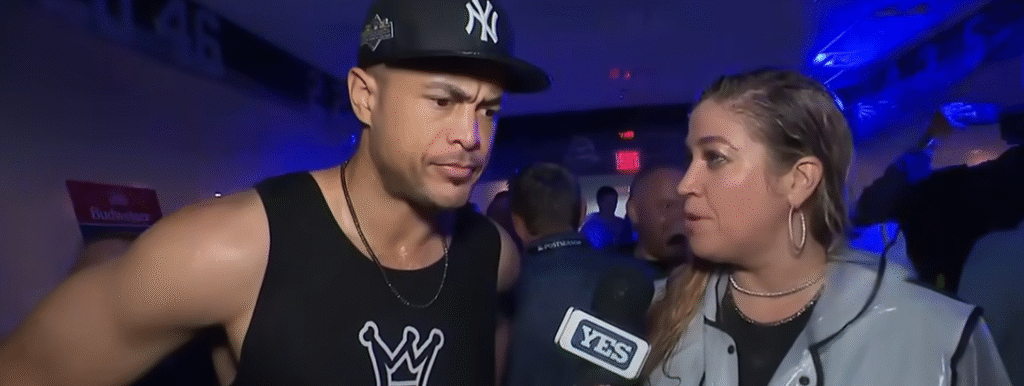The baseball community was shocked when Giancarlo Stanton signed a 13-year, $325 million contract with the Miami Marlins in November 2014. In addition to being enormous, the number was revolutionary, a financial declaration as audacious as Stanton’s swing. In a player whose unadulterated strength, youth, and charisma seemed destined to electrify an entire era, the deal represented unadulterated optimism.
His career and the Yankees’ financial future were drastically altered when he transferred that megadeal to them in December 2017. The Marlins at the time agreed to cover parts of the later years, which seemed like a wise decision but hinted at an impending financial struggle between longevity and value. The addition of a proven slugger to a team founded on power myths felt especially advantageous to the Yankees.
Stanton has a $32 million season-long guarantee as of 2025, with $29 million and $25 million due in 2026 and 2027, respectively. If the Yankees decline their 2028 team option, they will face a $10 million buyout. Notably, the Yankees’ burden has been greatly lessened by the Marlins’ continued annual contribution of almost $10 million toward the end of the contract. Nevertheless, given Stanton’s advanced age of 35, the purchase requires striking a balance between sentimentality and realism.
One can observe how Stanton’s career reflects the unpredictability of elite sports economics by looking at his most recent seasons. His performance has been erratic, alternating between frustrating absences and flashes of genius. He hasn’t participated in more than 114 games in a season since 2021. However, when healthy, his power is still incredibly effective; he has routinely hit home runs that change the tempo of games and boost fans’ spirits.
| Field | Data / Note |
|---|---|
| Name | Giancarlo Stanton |
| Born | November 8, 1989, Panorama City, California |
| Height / Weight | 6-6, 245 lb |
| Bats / Throws | Right / Right |
| Positions | Right fielder / Designated hitter |
| MLB Debut | 2010 with the Florida Marlins |
| Teams | Miami / Florida Marlins (2010–2017), New York Yankees (2018–present) |
| Major Awards / Honors | 2017 NL MVP, 5× All-Star, 2× Silver Slugger, ALCS MVP 2024 |
| Career HRs (to date) | 453 (as of 2025) |
| Career Hits / RBIs / AVG approx | ~1,619 hits, 1,169 RBIs, .258 average (through 2025) |
| Contract | 13 years, $325 million (signed November 2014) Wikipedia+2Spotrac+2 |
| Remaining Contract | 3 years (2025–2027) plus team option 2028, with contributions from Marlins toward final years Spotrac+4SI+4ESPN.com+4 |
| Average Annual Value | ~$25 million Spotrac+2Wikipedia+2 |
| Source / Reference | Spotrac page: “Giancarlo Stanton |

Those who once questioned Stanton are still thrilled by his postseason performance, which is astounding. He won the ALCS MVP award for his 2024 postseason campaign, which was marked by seven home runs and a 1.048 OPS. He reminded everyone why the contract once appeared visionary for a fleeting, brilliant moment. His booming bat still evoked memories of his MVP season in 2017, when he hit 59 home runs to lead the league. Critics were temporarily silenced by the powerful performance.
However, skepticism endures. The sustainability of such long-term agreements is questioned by analysts and fans, particularly when players are in their mid-thirties. The Yankees consider Stanton’s contract to be especially restrictive given their current heavy payrolls, which include Aaron Judge and possible commitments to Juan Soto. A player who was once unbeatable is now struggling with the boundaries of durability in this cautionary tale about promise colliding with biological reality.
In spite of the criticism, Stanton’s contract has had a significant impact on baseball’s financial situation. His contract paved the way for the subsequent huge extensions, including Mookie Betts’ $365 million contract, Mike Trout’s $426 million contract, and the startling half-billion deals in the late 2020s. All of them pay homage to Stanton’s bold example. In this way, his contract represents a cultural turning point as well as a financial commitment, signaling a change in the way athletic value is assessed on both an emotional and financial level.
Stanton has complete control over his story because he has a complete no-trade clause. He has accrued tenure and leverage as a 10-and-5 player. This autonomy, which represents a change in power where players are not only assets but also decision-makers controlling their own lives, is especially novel in sports contracts. This change has compelled teams’ front offices to adopt a more venture capitalist mindset, strategically investing in talent while anticipating depreciation.
Stanton’s contract has evolved over time to reflect risk, loyalty, and legacy rather than just financial matters. It has to do with the cost of greatness and the perseverance needed to cultivate it. Fans are briefly reminded that such rare talent makes the cost worthwhile when he hits a ball and sends it flying over the stands. Even though they are less frequent now, those moments are still unforgettable.
Naturally, comparisons to other celebrities are made, such as Mike Trout’s perseverance, Shohei Ohtani’s dual brilliance, and Aaron Judge’s leadership. The same paradox confronts them all: enormous compensation linked to human frailty. Stanton’s journey, however, feels particularly cinematic. Anyone who has ever struggled to prove their value after being written off will be able to relate to his journey through injuries, recovery, and resurgence.
